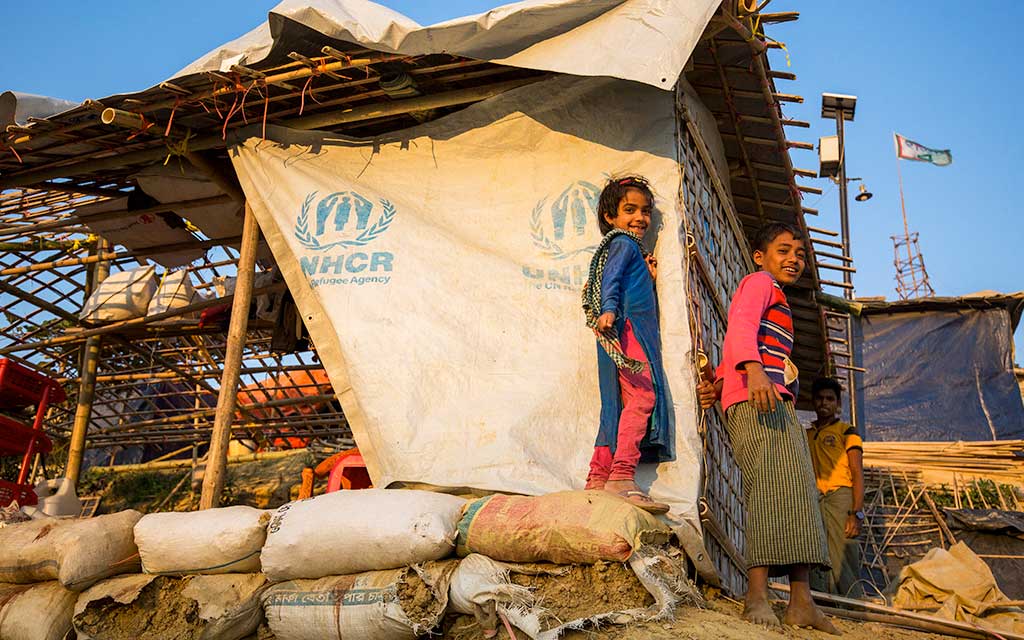‘Rohingya Refugee Crisis
Hajira and three-month-old Sadeka fled horrific violence in Myanmar during the Rohingya crisis.
Like so many other Rohingya families, they crossed the border into Bangladesh and now find themselves in the sprawling, overcrowded refugee camps near Cox’s Bazar.
Photo: ©UNHCR/Roger Arnold
Families like Hajira’s have been through so much.
Please help them to survive and rebuild their lives.

Shelter
including extra protection against monsoons

Clean water
to keep families safe from waterborne diseases

Essential items
like mattresses, blankets and kitchenware
What’s happening to the Rohingya people?
Violence and persecution in Myanmar have now driven over a million Rohingya from their homes. Rohingya refugees fled violence in Myanmar at a staggering rate in 2017 when violence broke out, including the burning of entire Rohingya villages.
At the peak of the crisis, thousands were crossing into Bangladesh daily. Most walked for days through jungles and mountains, or braved dangerous sea voyages across the Bay of Bengal to reach safety. They arrive exhausted, hungry and sick—urgently in need of protection and humanitarian assistance.
Who are the Rohingya?
The Rohingya are a stateless Muslim minority in Myanmar. Nearly a million Rohingya refugees have fled violence in successive waves of displacement since the early 1990s. The most recent mass migration began on 25 August 2017. Violence broke out in Myanmar’s Rakhine State, forcing over 943,000 Rohingya to seek asylum in Bangladesh. A significant portion of these are women and children, 52% are children under 17 years old. Many others are elderly and require additional aid and protection.
Where are Rohingya families fleeing to?
Most Rohingyan families cross the border into Bangladesh and end up in the refugee settlements of Kutupalong and Nayapara in the Cox’s Bazar district. But conditions there are tough and the scale of the influx is putting immense pressure on local facilities and services.
What are conditions like in the Rohingya refugee camps?
Throughout the Rohingya crisis, the camps have been vast, overcrowded and basic. Rohingya refugees have settled in and around Kutupalong and Nayapara refugee camps in Bangladesh’s Cox’s Bazar region, which have grown to become the largest and most densely populated camps in the world. Infrastructure and services there are stretched to their limits, with many families lacking adequate shelter, clean water and proper sanitation.
How is UNHCR helping?
UNHCR is working with partner organizations active in the area to support the Bangladesh government to provide appropriate response to the humanitarian crisis.
UNHCR has been on the ground in Bangladesh leading the emergency response efforts by distributing urgently-needed supplies such as tents, blankets, sleeping mats and solar lamps. UNHCR has provided thousands of latrines and built water access for refugees. This has reduced the risk of spreading disease and improved overall sanitation.
UNHCR teams lead the protection response and are hard at work in all the refugee camps of Cox’s Bazar—providing life-saving essentials to families. We also support education and healthcare initiatives. UNHCR also helps refugees strengthen their shelters and prepare for the monsoon season, which falls between May and September, increasing the risk of floods and landslides.
We continue to identify the most vulnerable new arrivals, such as unaccompanied children, pregnant women, the elderly and the disabled. Our protection staff are working to establish child-friendly spaces and to prevent sexual and gender-based violence.
Where can I access the latest data and reports?
Bangladesh Operation—latest reports on UNHCR relief work in Bangladesh overall.
Myanmar Situation Portal —for latest updates on the crisis overall, including UNHCR situation reports and funding requirements.
Did you know that 16 million litres of clean water are needed every day to supply Rohingya refugee camps?

Tasmin and Monir escaped violence in Myanmar, but now face another threat—monsoons.
As the rainy season begins and waters rise, their shelter in Kutupalong refugee camp is at risk of flash flooding and landslides.
That’s why UNHCR is helping their family to build a new, reinforced shelter and protect themselves against the heaviest of rains.
Photo: ©UNHCR/Roger Arnold
Donate Today
Please help Rohingya refugee families in need.
Donate Today
Please help Rohingya refugee families in need.


